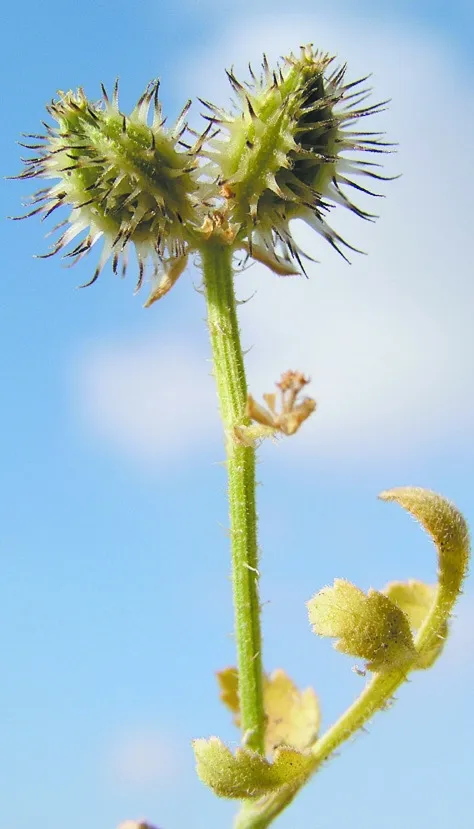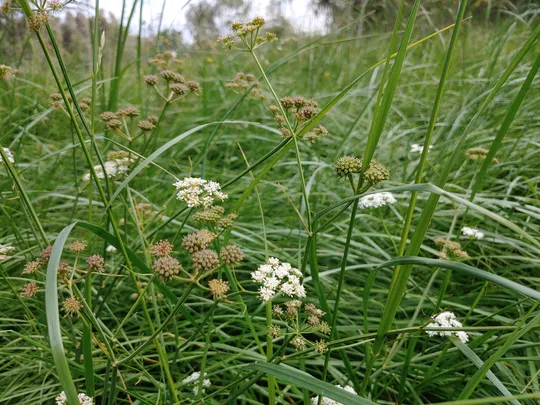Water Parsnip
Berula erecta
Berula erecta grew in the past only in the Hula marshes. It was collected five times form water bodies in the Hula Valley (Hula marshes, between Malaha to Ǧahula, on the margins of the Jordan River) from 1951 to 1954, and has since been extinct. According to the Flora Palaestina the species was also recorded from the Kinarot Valley (the Sea of Galilee) and from Amon. It was collected in Jordan from the Azraq Lake in the eastern desert, and this is apparently the record from the Gil’ad (Danin 2004). Berula was recently found (Ravak and Shmida, 2000) in the Iben Hamad Canyon in Moab in Jordan, in an artificial water canal.
Marshes, edges of rivers and flowing canals. Can apparently grow with its lower parts immersed in shallow water, but requires exposed areas for germination.
The genus Berula includes three species found in the temperate zones of Eurasia. B. erecta is the southernmost species in the genus.
• Wetlands, the habitat of Berula erecta, are the most threatened habitat in Israel, for the past sixty years to the present. It grew in at least three sites in the Hula marshes, which were drained in the 1950s, before it became extinct. No less than 8 (!!!), aquatic plants exclusive to Israel, have become extinct since the drainage: Berula erecta, Utricularia australis, Ludwigia palustris, Hydrocharis norsus-ranae, Marsilea minuta, Hydrocotyle vulgaris, Scutellaria galericulata and Rorippa amphibia. At least three other extinct aquatic plant species grew in the Hula and in the Sharon: Nymphaea Alba, Ranunculus ophioglossifolius and Potamogeton lucens.
• Although B. erecta is known as a successful immigrant, it seems that it does not succeed in our area, but only in climates with rainfall throughout most of the year. In our region it is a peripheral species and its populations are fragmented, small and on the verge of extinction (in Moab only three specimens were found).
• B. erecta has an extensive global distribution and is not globally endangered.
Berula erecta should be reintroduced to the Hula marshes, to slow flowing clear water channels. A careful survey of the Hula Valley springs should be conducted to try to locate B. erecta. Such a survey has not been conducted since 1973, when the survey was only partial.
Berula erecta has a broad distribution, it grows from Western Europe to Afghanistan in Asia: in all the Mediterranean countries, from Spain through Italy and the Balearic Islands on to Turkey, Syria and Lebanon. In Europe, it grows in Germany, Eastern Europe, and the Balkans and around the Black Sea. In Asia – in Iran, Afghanistan and the Caucasus. The species penetrates the Sudanian region and is found in Sudan and Ethiopia. It invaded North America and Australia.
Berula erecta is an annual herbaceous plant, which grows only in wetlands. In Israel, it was found only in the Hula, where it became extinct following the drainage of the marshes. Its habitat is the most vulnerable in the country – at least 70 percent of the water bodies in Israel, springs, streams and winter pools, have been wiped out completely and/or their water regimes have been so severely altered that it is not suited for the growth of aquatic plants and the typical aquatic plant associations. In the Hula Valley, the situation is a little better: "only" 50 percent of the water bodies in the valley were destroyed, in addition to the “disaster" of the Hula marshes and in particular its springs. Unfortunately, the reserve does not include spring habitats, where the unique diversity of aquatic plants was concentrated (Paz, 1973), but action must be taken to preserve them and to declare as many wetlands as possible in the Galilee as nature reserves.
Current Occupancy Map
| 1000 squre meter pixel | 5000 squre meter pixel | 10000 squre meter pixel | |
|---|---|---|---|
| number of observations | 0 | 0 | 0 |
| in total pixels | 0 | 0 | 0 |
| Family | Apiaceae |
| Classification | On the endangered species list |
| Ecosystem | Mediterranean humid |
| Chorotype | Euro – Siberian and Northern Mediterranean |
| Conservation Site | Agamon HaHula and Nature Reserve |
| Rarity |
1
5
6
|
|---|---|
| Vulnerability |
0
0
4
|
| Attractiveness |
0
0
4
|
| Endemism |
0
0
4
|
| Red number |
1
-1.0
10
|
| Peripherality | N |
| IUCN category | DD EW EX LC CR EN VU NT |
| Threat Definition according to the red book | Extinct |
 Based on:
Based on:






